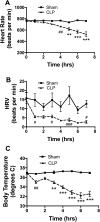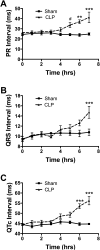Impaired heart rate regulation and depression of cardiac chronotropic and dromotropic function in polymicrobial sepsis
- PMID: 25271380
- PMCID: PMC4297223
- DOI: 10.1097/SHK.0000000000000272
Impaired heart rate regulation and depression of cardiac chronotropic and dromotropic function in polymicrobial sepsis
Abstract
The scope of cardiac pathophysiology in sepsis has not been fully defined. Accordingly, we evaluated the effects of sepsis on heart rate (HR), HR variability, and conduction parameters in a murine model of sepsis. Electrocardiograms were recorded noninvasively from conscious mice before and after cecal ligation and puncture (CLP) or sham surgery. Responses of isolated atria to tyramine and isoproterenol were quantified to assess the functional state of sympathetic nerves and postjunctional sensitivity to adrenergic stimulation. Cecal ligation and puncture mice had lower HR compared with sham at 16 to 18 h postsurgery (sham, 741 ± 7 beats/min; CLP, 557 ± 31 beats/min; n = 6/group; P < 0.001), and there was significant prolongation of the PR, QRS, and QTc intervals. Slowing of HR and conduction developed within 4 to 6 h after CLP and were preceded by a decrease in HR variability. Treatment of CLP mice with isoproterenol (5 mg/kg, intraperitoneally) at 25 h after surgery failed to increase HR or decrease conduction intervals. The lack of in vivo response to isoproterenol cannot be attributed to hypothermia because robust chronotropic and inotropic responses to isoproterenol were evoked from isolated atria at 25 °C and 30 °C. These findings demonstrate that impaired regulation of HR (i.e., reduced HR variability) develops before the onset of overt cardiac rate and conduction changes in septic mice. Subsequent time-dependent decreases in HR and cardiac conduction can be attributed to hypothermia and would contribute to decreased cardiac output and organ perfusion. Because isolated atria from septic mice showed normal responsiveness to adrenergic stimulation, we conclude that impaired effectiveness of isoproterenol in vivo can be attributed to reversible effects of systemic factors on adrenergic receptors and/or postreceptor signaling.
Figures







References
-
- Rudiger A, Singer M. The heart in sepsis: from basic mechanisms to clinical management. Curr Vasc Pharmacol. 2013;11:187–195. - PubMed
-
- Werdan K, Oelke A, Hettwer S, Nuding S, Bubel S, Hoke R, Russ M, Lautenschlager C, Mueller-Werdan U, Ebelt H. Septic cardiomyopathy: hemodynamic quantification, occurrence, and prognostic implications. Clin Res Cardiol. 2011;100:661–668. - PubMed
-
- Wilhelm J, Hettwer S, Schuermann M, Bagger S, Gerhardt F, Mundt S, Muschik S, Zimmermann J, Bubel S, Amoury M, Kloess T, Finke R, Loppnow H, Mueller-Werdan U, Ebelt H, Werdan K. Severity of cardiac impairment in the early stage of community-acquired sepsis determines worse prognosis. Clin Res Cardiol. 2013;102:735–744. - PubMed
-
- Werdan K, Schmidt H, Ebelt H, Zorn-Pauly K, Koidl B, Hoke RS, Heinroth K, Muller-Werdan U. Impaired regulation of cardiac function in sepsis, SIRS, and MODS. Can J Physiol Pharmacol. 2009;87:266–274. - PubMed
Publication types
MeSH terms
Substances
Grants and funding
LinkOut - more resources
Full Text Sources
Medical
Research Materials
Miscellaneous

